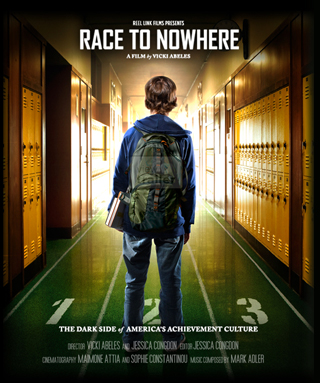The film “Race to Nowhere“ tackles the topic of over-scheduled, stressed out school-age children and their parents eager to secure a spot not only in a college, but a 'good' college. We need some balance. The scale is tipping more and more in one direction, and “Race” is the counterbalance demonstrating the need to re-center our education system and give parents the support to help get it there.

In my view, this race to the top of higher-education has also become compulsory in the college-admissions industry which is increasingly driven by supply and demand .
Here's some good news on the supply side. There are 3,000,000 high school juniors, about 4,000 colleges accepting 1,000 freshman on average in the United States. This means that roughly 4,000,000 students could have a spot at a college — not at an Ivy League nor perhaps at a top 50 university, but at a college nonetheless.
Now for the bad news . There are 37,000 high schools in the USA, (about 1,000 just in California). This means that there are 37,000 Valedictorians, ASB Presidents, etc. who, according to our school counselor, about 80% do not get into their college “of choice”. However, the most incredible number to consider is the number of applications each college reportedly receives for the number of spots they have available. In the last couple of years, Harvard received roughly 35,000 applications for approximately 1,200 spots.
It is clearly a numbers game starting freshman year of high school when grades become a permanent record on a student's transcript; the competition is fierce in both academics and sports to try to stand out as a student and/or athlete in high school and on college applications in the hope of securing a spot at a prestigious school.
What are students racing to be on top of? Well, of everything a high school student is normally in competition with others for: academics, sports, community service, popularity, ASB, scholarships, etc. Why? Because ultimately, if you do not have a phoneme on your hands, then you'll have to push to produce one to at least have a chance of getting into one of the elite schools in this country (sounds a bit like the Tiger Mom approach, right?) because it will open doors on the job front faster than any other degree.
In a Wall Street Journal article titled, “Rethinking the Cost of Attending an Elite College” Dr. Joseph Losco, an expert on the history of education, refers to this thinking as, “The cultural view that an elite college degree is the gold standard for both parents and students … validating their worth in society.” Having the 'best' education possible has become the ultimate measure and guarantee of life-long security and happiness — or so we've been brainwashed into thinking. Parents feel compelled to pressure their kids to perform so they can both be rewarded: the kid goes to a good school, the parents can brag about it.
I'm not against having high goals for our children. Heck, I have them for my own kids and had them for myself back in the day, too. What I came away with after watching “Race to Nowhere” was this: not every kid belongs at a top college, but we've all been following the same roads which unfortunately don't all lead to Princeton. At times, it also feels like high schools and colleges are in collusion to squeeze out the weakest students because not everyone can afford tutors and extra SAT prep courses to get ahead of the rest. But there is no other way of winning the college-race except to join the labor-intensive education system we've been offered.
“Race To Nowhere” does an excellent job of highlighting what this obsessive path to a higher education has done to kids across America; it has stolen their youth and made them into fiercely competitive machines in both academics and sports at the cost of everything and everyone else. The obvious sacrifices students and families are making are: cutting back on family time, vacation time, down time, sleep, healthy minds, and sadly for a some, even their lives. One of the focal stories of the film is the suicide of a 13 year old over a bad math grade.
As the movie points out, most of these pass times have been replaced by loads of AP (Advance Placement) homework; two to three hours of sports a day because coaches own their athletes wily nilly; down time is now a bad thing since it's equated to computer time, mindless TV time or hanging out with friends; sleep, well, this is the easiest one to forgo. (I'm exhausted just writing about this! )
Recently, my child explained to me that a teacher had asked the students in her class to choose if they wanted more time to do their homework in class or not. Of course, the kids chose more time to do homework in class since this gives them more time to be free of it after school and do other homework or sports. However, this is done at the expense of having to rush through the lesson and harming those kids who can't keep up with the faster pace of the lesson. (I fail to see the benefit for the kids here)
On the other hand, the established college-admissions system remains unchanged. Students continue being weeded out by the demands of becoming a 'well rounded' (good at many things) student, or a 'well-angled' student (good and consistent at a few things). Can students really let up on the overburdening high school work load without getting penalized?
The movie dissects this problem to its core. Among the interviews this documentary is based on are some insightful moments with a Cal Berkley Admissions officer, staff members from Stanford University, physiologists, teachers, students, parents, and in the movie's happier note, with Blue Man Group cast member and founder of the Blue School — an alternative school focusing on the creative side of children and not simply on test-taking abilities.
How do we get back to that place where the goal is to work with a child's natural grad-level ability without the excessive pressures (and peer competition) of having to take college-level courses in high school to demonstrate that a 15 year old student can do college-level work? What can we do to put a little sanity back into to our kids lives?
While “Race to Nowhere” doesn't have all the answers to these questions, it does offer valid starting points for school administrators and parents to work towards getting back that balance we've lost:
· Less (busy) homework – No homework on weekends and holidays
· Working with kids' creative side – Not just focusing on their testing results
· Not teaching specifically to the tests – Is a student merely a number?
· Using class time to teach, and not hurrying through the lesson to give kids time to start their homework because they don't have enough time for it at home.
· Getting parents to understand that a prestigious college education is not the nirvana it's painted out to be.
I was impressed by our Superintendent's immediate call to action after the movie. A panel of experts made up of the district counselor, the ASB president, a Dr. in the History of Education from San Diego State University, and the school counselor listened to questions from the audience and established an Education Summit to discuss what changes they could implement to restore balance to our kids lives…one less homework assignment at a time.
Do you subscribe to the notion that going to a certain college is your child's key to success?
Is there no other way but to get with the program or be left out of the race?
Do you support your teachers and coaches without questioning their actions even if you see it is exacting too much from your child without much real benefit? Why or why not?
Has your school made any changes as a result of this movie?








Speak Your Mind